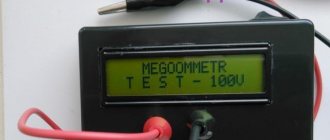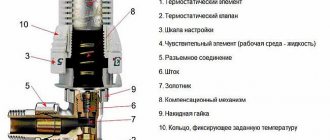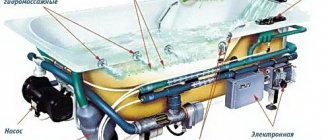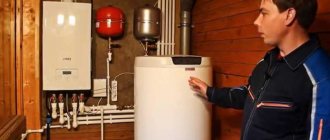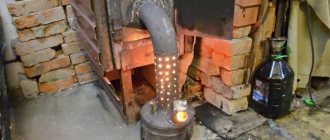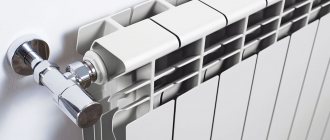There is nothing more pleasant than being in a warm room on a frosty winter day, and even at night. Heating radiators provide the most uniform and comfortable heating of rooms. But it also happens that it gets warmer outside, and the batteries continue to work at maximum power. Then there is no need to talk about comfort.
The house becomes hot and stuffy, which disturbs sleep and worsens well-being.
To prevent this from happening, thermostats were invented.
Purpose of installation and operating principle
Properly selected and correctly adjusted thermostatic valves help save money on energy costs and maintain a comfortable room temperature. Modern boilers can be equipped with similar devices. But in this case it will change, heating all the rooms at the same time.
Unlike sensors on boilers, thermostats allow you to set the required level of radiator heating for each room. This mechanism is indispensable for centralized systems.
The thermostatic valve regulates the amount of coolant entering the battery depending on the ambient temperature. The mechanism works to lower temperatures, but is not capable of increasing them. The heating is limited automatically; it is enough to adjust the mechanism after installation.
Operating principle of the mechanism
The operating principle of the thermostat is simple. One side of the tube is located within the cooling zone and is attached to the evaporator. While cooling, the lever of the operating thermal relay opens the contacts. When the temperature inside the chamber rises, the thermostat used for the refrigerator closes the electrical circuit. A small spring, to which a temperature adjustment handle is attached, is responsible for moving the contacts. Changing the position of the lever adjusts the spring tension level. This is reflected in the pressure in the freon tube and the reaction of the electrical contacts.
An electronic refrigerator thermostat works differently, although the principle is the same. The required temperature values are achieved by heating or cooling the capillary tube. Modern refrigerators are equipped with electric modules that simultaneously issue commands to a group of sensors. The diagram of the device is shown in the picture below.
Device
The operating principle of a thermostatic valve may differ depending on the type of device.
But the design of any model is based on a thermal valve and a thermostatic head. A valve is a valve consisting of a seat and a shut-off cone. This part opens or closes the flow of coolant after reaching the user-set temperature in the room. The operation of the thermal valve is controlled by a thermostatic head, that is, a temperature sensor.
Any thermostat is equipped with an arrow that indicates the direction of coolant flow. When installing the device, its direction must coincide with the coolant circulation pattern in the system.
Design features
The thermostat is a relay with a sealed tube filled with freon at one end. The reverse side is connected to the compressor using electrical contacts. The number of contacts varies from two to six. The gas tube has a length from 80 cm to 2.5 m. This depends on the set of tasks assigned to the thermal relay.
The type of thermostats used depends on the design of the refrigerator - single-compartment, two-compartment, dual-motor two-compartment or freezer. Thermostats differ in temperature indicators, as well as in design. Some refrigerator thermostats have a special locking bar, while others do not. The diameter of the handle rod and bellows tube may be different.
Kinds
Thermostats on the market differ in the way they are controlled.
Mechanical
Provide manual adjustment of coolant flow. These are inexpensive models, easy to set up and do not cause malfunctions. Mechanical thermostats consist of a gas or liquid bellows, an actuator and a regulator. The valves of such mechanisms have a scale indicating the degree of heating of the radiator.
The installation is carried out experimentally, by gradually turning the valve. When the valve is turned, the coolant enters the spool and affects the position of the rod, which, under the influence of pressure, blocks the coolant flow.
The disadvantage of such devices is the need for regular adjustments, depending on the ambient temperature.
Electronic (automatic)
Microprocessors are installed inside such thermostats, which are responsible for regulating the heating of the radiator. The mechanisms are equipped with sensors that allow them to measure the ambient temperature and, in accordance with it, regulate the supply of coolant to the radiators without human intervention. Automatic models are configured using the keypad.
The mechanical part of such a thermostat is no different from manual models. The bellows in them are cylindrical, and the walls are made in the form of corrugation. Inside the bellows there is a substance that reacts to the ambient temperature. When heated, it expands, and the pressure inside the device increases, affecting the position of the rod. It regulates the volume of coolant entering the radiator. When the temperature decreases, the reverse process occurs.
Expert opinion
Torsunov Pavel Maksimovich
Such a thermostat is very reliable, the bellows can withstand tens of thousands of compressions and expansions, its resource will last for more than 10 years.
Among electronic thermostats, two types of devices can be distinguished:
- Closed . They cannot determine the temperature automatically, so the user must make the settings independently. Its advantage over a manual device is only that you can set the temperature in degrees, and not like on a graduated scale of more or less.
- Open ones are complex electronic devices with programming capabilities. When the temperature rises or falls to a certain threshold, the device automatically changes its operating mode to the one set by the user.
Electronic thermostats operate from replaceable batteries – batteries. It does not consume much energy, so frequent replacement is not required: no more than 2 times during the entire heating season. There are models that have a battery with a charger.
Types of thermostats for refrigerators
There are two types of thermostats:
- mechanical;
- electronic.
The electronic thermostat is an electronic plate on the display of which all data is displayed. This is the most advanced device; it records temperature changes with greater accuracy. But equipment with an electronic control module is expensive, so mechanical thermostats are more often used.
Reference. The mechanical thermostat can be replaced with an electronic one.
There are three main types of mechanical regulators on the market:
- Russian (Oryol plant) - TAM series;
- made in Denmark - Danfoss;
- Italian (Ranco company) - K-50, K-52, K-55, K-56, K-57, K-58, K-59.
They are used in refrigeration equipment "Minsk", "Orsk", Beko, Candy, Indesit, Bosch, Ardo, Samsung, etc.
The most common thermostats include:
- TAM-112, TAM-113 - used in single-chamber units, analogous to K-50;
- TAM-125 - installed in freezers of 2-chamber 2-compressor equipment, analogous to K-57;
- TAM-133 - used in refrigeration chambers of 2-chamber units, analogue of K-59, Danfoss 077B6;
- TAM-145 is a 3-pin freezer temperature controller with a defrost alarm (red light on the control panel).
Criterias of choice
When selecting a thermostat model, most users focus on price. Mechanical models are several times cheaper than electronic ones, but at the same time less convenient to operate. The most convenient are electronic devices with programming capabilities.
With their help, you can set the temperature for different time periods. Such thermostats are able to turn off the heating for the period when no one is in the apartment, and bring the temperature to comfortable values at the required time. You can also program day and night modes for heating the room.
Thermostats also differ in internal content:
- Devices with bellows filled with liquid are inexpensive, but their response to temperature changes in the environment is somewhat slower.
- Gas-filled thermal heads are very sensitive to any temperature fluctuations. They will “notice” if the air in the room becomes warmer because the sun is shining through the window and will close the valve, stopping the supply of media.
This criterion is important to consider when purchasing a specific model.
It is also important to take into account the following differences between gas and liquid thermostats:
- Gas-powered devices have a long service life. At the same time, the gas reacts smoothly to temperature changes, which does not cause excessive sudden loads on the device. Liquid ones operate quickly, which has a greater impact on the wear of working parts, but allows you to quickly respond to a drop or rise in temperature.
- In liquid thermostats, the sensor can be remote or built-in. If it is built-in, then the device is placed in a horizontal position to reduce the influence of convection currents from the radiator and pipes.
- It is advisable to install remote-type sensors when the device is covered with thick curtains that affect heat transfer, the thermostat is located vertically, the radiator is installed in a deep wall niche or too close to the window sill.
Thermostat location
The location of the regulator depends on the refrigerator model. Information about its structure and location is contained in the operating instructions for the household appliance . It is usually located next to the temperature control knob. In old household appliances, the thermostat is installed inside the chamber, under the light bulb, and covered with a protective housing. To remove the part, remove the handle by pulling it towards you. Then unscrew the screws and dismantle the housing.
In modern models, the thermostat is located outside, usually above the door. If it needs to be removed, first also remove the adjustment knob. Then unscrew the bolts and remove the panel with the light bulb, after which the regulator is removed.
Best models
Manufacturers offer customers various models of mechanical and automatic thermostats for radiators. The following devices received the greatest number of positive reviews.
Valtec corner 1⁄2
The Valtec brand has been trusted by plumbing experts for several decades. This thermostat model is an angle valve for installation in a system with a maximum temperature of up to 110 degrees and a pressure of no more than 10 bar.
Advantages of the model:
- compactness and ease of installation;
- durability (up to 30 years) and maintainability;
- combination of quality and low price.
The disadvantages of the model include:
- risk of flooding of the apartment if the pressure in the pipes rises to more than 10 bar.
Danfoss RA 2994
Model with gas filler, combined with the RA-G valve, which allows servicing single-pipe heating systems. The thermostat of this brand is designed for diameters from 15 to 25 mm. Danish-made equipment has been familiar to domestic specialists since the 70s of the last century. The devices are compatible with any heating boilers.
The clip connection of this model allows for simple and precise attachment of the thermocouple to the valve. Technical characteristics of RA type radiator thermostats comply with European standards EN 215–1 and Russian GOST 30815–2002.
Advantages of the model:
- easy installation and setup;
- possibility of precise temperature control;
- acceptable cost.
Many users consider the disadvantage:
- low maximum temperature threshold - only up to 26 degrees.
Techem HKR
Universal automatic mechanism with a large informative display.
Powered by batteries, which ensures autonomous operation. Equipped with an effective safety system and protection against lime deposits, freezing and jamming of valves. It is possible to program several modes. Users note the ease of control of the mechanism and simplicity of settings. Separately, it is worth noting the ability to set a certain temperature for several days in advance. This model has practically no drawbacks, other than the instructions being too small.
FIBARO. The Heat Controller for Apple Homekit
A smart device running Apple HomeKit to control room temperature using Bluetooth wireless technology. An advanced control algorithm and scheduled operation allows you to save up to 42% on heating bills.
The FIBARO thermostat works with 98% of radiators available on the market. The built-in battery, charged via USB, is enough for the entire heating season. Operating temperature: 0-40 degrees.
Advantages of a thermostat:
adaptation to weather and indoor conditions;- compatibility with different heating sources;
- schedule adjustment with the ability to make temporary changes;
- temperature adjustment depending on the geolocation of users;
- raising the temperature to an optimal level when motion is detected in the room;
- turning off the heating when an open window is detected;
- use voice commands to adjust temperature;
- child lock;
- the presence of an automatic descaling mode;
- Temperature measurement accuracy is up to 0.5 degrees.
Sibling Powerswitch-ZK
Smart thermostat with remote control: according to a set schedule, according to sunrise/sunset, set temperature or air humidity outside. Maintains the set temperature by controlling a conventional damper rod of a home radiator. It is possible to add a device via a gateway to a security system and other elements of a Sibling brand smart home. Operating temperature range – from 0 to + 40 degrees.
Zigbee Ya-HY368
The smart temperature controller is battery-powered, is a wireless device and is used in conjunction with the Ya-ZB1 multifunctional ZigBee gateway “I am Smart” controlled by the “I am Smart” mobile application. Easy to install, mounted in the same way as a traditional manual radiator temperature controller.
The screen and buttons provide intuitive operation. Using the Ya Smart application allows you to remotely set schedules, view and set the temperature. Equipped with built-in clock and calendar
Advantages of the model:
- schedule for a week in advance, energy saving modes;
- four independent time periods for setting temperatures throughout the day
- mode selection by pressing one button;
- control of several thermostats installed in different places (for example, in a country house, administrative buildings or office center) from one mobile application;
- control via the Internet without a subscription fee.
- local (from the controller display) and remote (from a mobile application) mode of monitoring and setting the temperature of the rooms or heated floor;
- the ability to work without connecting to ZigBee and the Internet; in the absence of a Wi-Fi network or the Internet, the controller operates according to the specified parameters. The schedule is stored in the thermostat's memory;
- creating various scenarios together with other “I am Smart” devices;
- automatic calibration and regular self-testing prevent valve sticking and lime deposits;
- safety: frost protection, child protection, automatic protection against valve clogging through independent actions without human intervention.
- automatic switching of heating to economical mode in the house when leaving home (based on geolocation or the presence of a phone in the home Wi-Fi network);
- setting a schedule for setting different operating temperatures throughout the day and week.
The only drawback is the high price.
Electric boilers
A fairly common alternative to gas and solid fuel boilers. Lots of advantages, high efficiency, but long payback period. The connection is simple, like with gas boilers, but without a cold water supply. Temperature regulation and overheat protection are provided.
Mechanical boiler timer
Using a simple mechanical timer for an electric boiler, there are three options for starting the central heating system :
- The boiler is turned off;
- The boiler supplies warm water;
- The boiler turns on and off at the set time.
Mechanical timers usually have a large round dial with a 24-hour scale in the center. By turning the dial, you can set the desired time, and then leave it in that position. The boiler will turn on at the right time. The outer part consists of a set of tabs for a 15-minute period, which are inserted for easy adjustment of operation and mode settings. Emergency reconfiguration is possible, which is performed with the boiler connected to the network.
Mechanical timers are easy to set up, but the boiler always turns on and off at the same time every day, and this may not satisfy the owners if the family is large and bathing procedures are carried out several times a day at different times.
Installation Rules
Thermostats are installed at the inlet or outlet of the radiator. Installation is standard - on linen winding or FUM tape. The process itself is also standard. The thermostat has a thread for which the appropriate fittings are selected. Or taps are used to cut internal threads on a metal pipe.
When choosing an installation location, consider the following:
- Recommended height. This item is indicated in the technical documentation for the device. Each device is calibrated at the factory to control temperature at a certain altitude. As a rule, this is the upper radiator manifold, approximately 60-80 cm.
- If the radiators only have a bottom saddle connection, there are three options: look for a device that can be installed at the bottom, install a model with a remote sensor, or reconfigure the thermal head. The procedure is simple; the description must be in the passport. You will need to have a thermometer and at certain moments turn the head in one direction, then in the other direction.
What thermostat is on your radiator?MechanicalElectronic
- An important point that those who want to install a thermostat for a heating radiator in apartment buildings should remember. If you have a single-pipe installation, they can only be installed if there is a bypass - a section of pipe that stands in front of the battery and connects the two pipes to each other. If you have a similar wiring (there may not be a pipe on the right), a bypass is required. The thermostat should be installed immediately behind the radiator. Otherwise, you will regulate the entire riser, and the neighbors will not like this. For such a violation, a very substantial fine can be issued. Therefore, it is better to install a bypass.
- In two-story buildings, the recommended location of the thermostat is on the second floors. This is where the warm air is directed, and the first floor invariably turns out colder.
- Thermostats with sensors are installed in rooms where air movement is not obstructed. The indicator is placed strictly horizontally so that it shows a reliable picture. It should be taken into account during installation that the thermostat valves are equipped with an external thread on one end, and oriented inward on the other.
- It is not allowed to place automatic thermostats behind thick fabric drapery or behind a decorative screen. If you do this, the system will begin to measure the heating inside the cavity that appears, and not in the room itself. The solution to the problem is either the use of a remote sensor, or placing the regulator on horizontal sections of the system, as close as possible to the entrance to the radiator.
If the heating system is not created from scratch, before installing the thermostat, all water should be drained from it before installation work begins. When the heating season ends, the thermostat is opened to avoid the accumulation of sediment inside the mechanism.
Where is the thermostat located in the refrigerator, how to remove it for replacement or repair
The thermostat is installed outside or inside the device, where it is enclosed in a protective housing. In old refrigerators, the relay is located on the right, under the light bulb in the refrigerator compartment; in modern refrigerators, it is usually located outside . Before checking the refrigerator thermostat at home, you need to carefully read the available instructions.
Location in Indesit
You can find out where the thermostat is located in the Indesit refrigerator from the documentation from the manufacturer. In appliances produced in recent years, it is mainly installed above the door. In order to get it out, you will need a Phillips screwdriver . First, remove the handles, remove the casing from the latches, unscrew the screws that secure the strip with the signal light - there you can see the relay.
Location in Atlanta
In earlier models of Atlant refrigerators, the thermostat is placed in a small plastic box with snap-on latches, which is located on the panel. To get to it, simply remove the handle for switching the temperature and unscrew the housing protecting the thermostat.
Location at other manufacturers
In modern models, the placement of the thermostat may be different. When searching, you need to rely on the location of the relay handle. It is attached to a streamlined box or panel. If you remove them, you can find the part.
How to set up the device
All thermostats have factory settings. But the specified values are standard and may not coincide with the desires and requirements of users. In automatic models, it is enough to set the temperature on the display. The situation is more complicated with mechanical thermostats. To adjust them you will need a thermometer.
To change settings, do the following:
- Close all windows, doors, turn off hoods. Set the thermostat head to the extreme left position - “open”.
- As soon as the room temperature begins to rise and reaches 5 - 6 degrees above the desired value, turn the knob to the right - “closed”.
- The radiator will begin to cool down. Once the temperature readings reach the desired values, slowly begin to turn the head to the left. When you hear the noise of the coolant, stop and remember the position of the valve. To achieve the desired temperature, you will need to install the head in this position.
There will be no universal position for the mechanical thermostat. During the heating season, it will need to be periodically reconfigured, depending on weather conditions.
Tips from repair experts
- Before replacing the relay (removing panels, casing and housing, disconnecting wires and other operations), remember, write down the sequence of actions or photograph each stage of dismantling - this will be useful when assembling a household appliance.
- Be extremely careful and careful when handling the bellows tube: this part is easy to damage, and incorrect position of the element or kinks will lead to incorrect operation of the refrigerator.
- It is unacceptable to solder relay wires to the terminals - this can lead to failure of the element, breakdown of insulation, or short circuit to the metal body of the household appliance.
The operating mode of the refrigerator compressor depends on the correct operation of the thermostat. A malfunction of the temperature relay leads to rapid failure of the equipment, so at the first sign of a breakdown of a functional unit, it must be repaired or replaced.
FAQ
Are modern thermostats compatible with old cast iron radiators?
In principle, thermostats can be installed on any battery. But the effectiveness of working on cast iron radiators is questionable. Such batteries are massive, hold a large amount of coolant and are therefore inert. They will respond too slowly to automatic adjustment using thermal heads. On old-style radiators, it is preferable to install a valve on the supply and a balancing valve on the return.
Is it worth installing a thermostat if there is a ball valve on the radiator and you can use it to regulate the heating of the room?
The ball valve does not regulate temperature effectively because there are only two preset modes: open and closed. If you try an intermediate position, the coolant will quickly damage the working part and the faucet will fail.
If there are several radiators in the room, should a thermostat be installed on each one?
It is not advisable to install thermal heads on every heating device. Only those radiators whose total thermal power exceeds 50% of the generation in a particular room are subject to adjustment. When there are two radiators, set the thermostat to the one that is more powerful. If there is equality in this indicator, they focus on the device closest to the heat source.
Installing a thermostat on batteries is an easy way to ensure a comfortable room temperature and at the same time save on energy costs. By choosing an automatic model, you will completely ensure uninterrupted heating operation without daily monitoring.
Signs of a broken temperature relay
There are a number of signs indicating a thermal relay failure:
- violation of cyclicity in the operation of a household appliance (the unit operates for a long time without switching off on its own);
- rapid growth of a layer of frost in the freezer, the appearance of ice in the refrigerator compartment;
- The electrical device does not turn on for a long time.
Such problems may indicate a malfunction in the relay or be a consequence of other refrigerator malfunctions (refrigerant leaks, motor failure, door seal failure, etc.).
Reference
The exact reason for the incorrect operation of household appliances can only be determined after diagnostics.
Snow coat in the freezer
If you find a significant layer of frost on the walls of the freezer, first make sure that the temperature mode is selected correctly and check the tightness of the chamber door. If everything is in order, there is a high probability of a thermal relay malfunction.
After setting the set temperature in the freezer, the failed sensor does not send a signal to the start relay of the refrigerator compressor about the need to complete the cooling cycle. The motor continues to work, the evaporator does not have time to thaw, and a snow crust quickly grows inside the chamber.
If the refrigerator is equipped with two thermostats and independent temperature control in the compartments, ice may form in the freezer and refrigerator compartment.
Disconnected and silent
Reasons for the refrigerator to turn off:
- external factors (for example, loss of power due to a power surge, faulty socket, plug or cable);
- breakdown of the engine start relay, electric motor;
- failure of the thermostat.
A broken relay does not respond to an increase in the temperature level in the refrigerator compartment, a signal is not sent to the start relay, and the motor does not turn on.
A sign of a malfunctioning thermostat is the complete absence of noises, sounds, or clicking sounds in the refrigerator, which indicate attempts to turn on the motor.
Doesn't turn off on its own
The reason for the lack of shutdown of the unit, in addition to violation of the rules for operating household appliances, loose door fit, breakdown of the start-up relay, refrigerant leak, may be a malfunction of the thermostat, which ceases to signal the need to stop operating the compressor. The motor continues to work without stopping, which leads to its overheating and failure.
Ways to increase the heat transfer of batteries
The presence/absence of the opportunity to increase heat transfer depends on the calculation of the radiator power reserve. If the device is not able to produce more thermal energy, then no fittings will help.
You can try to change the situation in one of the following ways:
- First of all, you should check whether the filters and pipes are clogged. Blockages form both in old buildings and in new buildings, as various construction debris enters the system. When cleaning does not produce results, drastic measures need to be taken.
- Increase in coolant temperature. This can be done if there is an autonomous heating supply, but with centralized heating it is unlikely.
- Changing the connection type. Not all battery connection methods are equally effective. For example, a reverse side connection reduces power by about a quarter. The location of installation of the device also affects the heat transfer.
- Increasing the number of sections. If the location and method of connecting radiators are chosen correctly, and the room is also cold, this means that the thermal power of the devices is not enough. Then it is necessary to increase the number of sections.
If the heating system is equipped with batteries with temperature control, then they require a certain power reserve and this is their main drawback. As a result, heating installation costs increase, since each section costs money.
Comfort cannot be achieved if the room is cold or too hot, so adjusting the heat in radiators is a universal solution to this problem.
There are many devices on sale that are designed to change the volume of coolant passing through the radiator. Among them there are both inexpensive and high-cost products. They come with different adjustments: manual, electronic and automatic.
Adjusting screw for additional contact pair
Three-terminal thermostats of the TAM133-1M series have an additional contact pair between terminals 3 and 6. The design of such devices requires the presence of an additional adjusting screw in the block of electrical contacts (see photo below), ensuring correct positioning of the fixed contact of this contact pair: when the thermostat control shaft is moved to “Off” position, the plastic pusher should open the contacts; in any other position of the control shaft, the contacts must be closed.
Contact pair of terminals 3-6
The state of the contact pair connected to terminals 3 and 6 of the thermostat can be monitored through the round hole in the ground terminal plate.
Adjusting heating radiators
To understand the question of how to regulate heating batteries with a regulator, first of all, you should find out the principle of their operation. By design, the radiator consists of a labyrinth of pipes and fins of various types, which provide increased heat transfer.
Hot liquid enters the device, passes through the labyrinth and thereby heats the metal, which gives off heat to the surrounding air. The fins on modern radiators are made of a special shape, which improves the convection of air flows, and the room is heated quickly.
In the case of active heating from the batteries, a heat flow is felt. This means that when you change the amount of coolant passing through the device, you can adjust the room heating temperature, albeit within certain limits.
This is what special fittings are designed for - thermostats and valves. But a heating regulator installed on a radiator in an apartment is not capable of increasing heat transfer; it can only reduce it.
The effectiveness of changing battery temperature depends on:
- on whether the heating devices have power reserves;
- from the correct selection and installation of regulators.
Of no small importance is the inertia of the entire heating system and the batteries themselves. For example, cast iron, which has a large mass, changes temperature slowly, while aluminum heats up quickly and cools down the same way. This means that there is no point in having cast iron radiators with temperature control, since it takes a long time to get results.
Safety rules to follow when checking
A refrigerator is a large household appliance that requires high voltage to operate. There are three main threats that potentially exist if you decide to repair your refrigerator:
- electric shock (high voltage appears on the contacts of the relay, thermostat, on the compressor windings);
- electric shock (short circuit inside the electrical wiring of the refrigeration device, due to exposed parts of the wiring getting into contact with the metal body);
- frostbite due to refrigerant contact with the skin.
Anyone who decides to repair the thermostat (or any other refrigerator component) must take serious precautions. You should not carry out work while the refrigerator is plugged in: be sure to turn off the power to the device.
As a result (or in the process) of repair work, wiring contacts are formed that should be connected to each other. All connections must be properly insulated. It is necessary to continuously check the presence of voltage on all surfaces capable of conducting current - the body, internal elements of the refrigerator compartment, etc.).
All tools (screwdrivers, pliers, multimeter terminals) must have insulated handles.


